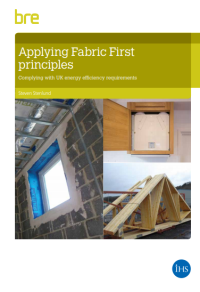Applying Fabric First principles: Complying with UK energy efficiency requirements FB 80
BRE (Building Research Establishment) is an independent, research-based consultancy, testing and training organisation, operating in the built environment and associated industries.
On 31 March 2016, BRE published; Applying Fabric First principles: Complying with UK energy efficiency requirements (FB 80), written by Steven Stenlund.
The 40-page guide provides an understanding of the principles of a 'Fabric First' approach to help developers and house builders design and build homes to meet energy efficiency requirements - including possible future zero carbon or near zero energy homes). It explains how improved thermal performance, examined with reference to SAP 2009 (Standard Assessment Procedure) calculations for a sample housing development, can lead to optimising the fabric design of dwellings.
This includes:
- Position and orientation of dwelling types.
- Fabric improvements.
- Airtightness.
- Thermal bridging.
- Services improvements.
- Developing a standard main specification for application across the site.
The contents of the guide are:
- Executive summary
- Introduction.
- Technical appraisal.
- Determining a site-wide compliance specification.
- Further considerations.
- Appendix: Site scenarios.
[edit] Related articles on Designing Buildings
- Allowable solutions.
- BRE articles on Designing Buildings Wiki.
- BRE Buzz articles on Designing Buildings Wiki.
- BRE Buzz.
- Building Research Establishment.
- Code for sustainable homes.
- Fabric first.
- Fabric first investigation into net zero for existing buildings.
- Fabric first will safeguard heat decarbonisation.
- Passive building design.
- Passivhaus.
- Retrofit.
- Standard Assessment Procedure SAP.
- Zero carbon homes.
- Zero carbon non-domestic buildings.
Featured articles and news
RTPI leader to become new CIOB Chief Executive Officer
Dr Victoria Hills MRTPI, FICE to take over after Caroline Gumble’s departure.
Social and affordable housing, a long term plan for delivery
The “Delivering a Decade of Renewal for Social and Affordable Housing” strategy sets out future path.
A change to adoptive architecture
Effects of global weather warming on architectural detailing, material choice and human interaction.
The proposed publicly owned and backed subsidiary of Homes England, to facilitate new homes.
How big is the problem and what can we do to mitigate the effects?
Overheating guidance and tools for building designers
A number of cool guides to help with the heat.
The UK's Modern Industrial Strategy: A 10 year plan
Previous consultation criticism, current key elements and general support with some persisting reservations.
Building Safety Regulator reforms
New roles, new staff and a new fast track service pave the way for a single construction regulator.
Architectural Technologist CPDs and Communications
CIAT CPD… and how you can do it!
Cooling centres and cool spaces
Managing extreme heat in cities by directing the public to places for heat stress relief and water sources.
Winter gardens: A brief history and warm variations
Extending the season with glass in different forms and terms.
Restoring Great Yarmouth's Winter Gardens
Transforming one of the least sustainable constructions imaginable.
Construction Skills Mission Board launch sector drive
Newly formed government and industry collaboration set strategy for recruiting an additional 100,000 construction workers a year.
New Architects Code comes into effect in September 2025
ARB Architects Code of Conduct and Practice available with ongoing consultation regarding guidance.
Welsh Skills Body (Medr) launches ambitious plan
The new skills body brings together funding and regulation of tertiary education and research for the devolved nation.
Paul Gandy FCIOB announced as next CIOB President
Former Tilbury Douglas CEO takes helm.
UK Infrastructure: A 10 Year Strategy. In brief with reactions
With the National Infrastructure and Service Transformation Authority (NISTA).
























